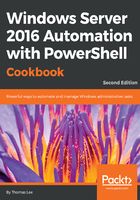
How it works...
In step 1, you install WSUS by installing the UpdateServices feature. Note the link for additional configuration instructions:

In step 2, you review what has been installed on your server by piping the results of Get-WindowsFeature to Where-Object, which filters the object passed in the pipeline. This object is referenced by the $PSItem variable (or the shorter $_) variable, returning only those that are installed—that is, those whose Installed property is $true. Installing the UpdateServices Windows feature installed the prerequisites, such as Web Server (IIS), automatically:

In steps 3 and 4, you create a folder to hold the WSUS update content, and then perform the post-installation configuration for WSUS:

In step 5, you review the log file written by WsusUtil.exe in the previous command. This log is useful for troubleshooting or for verifying a successful configuration:

In step 6, you view the websites on the WSUS1 server, noting the WSUS website, bound to HTTP on port 8530:

In step 7, you review the commands in the UpdateServices module, which you investigate in later recipes:

In steps 8 and 9, you use Get-WsusServer to create your $WSUSServer object and inspect the properties and methods:

In step 10, you use Get-WsusProduct to create and view the default collection of available product categories. Sadly, this list is out of date:

In step 11, you make your product categories current by synchronizing from the Microsoft Update servers, using a while loop to wait for the synchronization to complete. This can take several minutes when doing this for the first time:

In step 12, you check the result of the synchronization:
